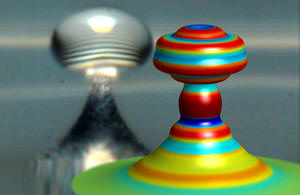
Optomechanical GHz Oscillator and Spectroscopy.
Just like the spectral signature of
materials originates from molecular vibrations, photonic devices have many spectral lines originating from their different mechanical modes. Our group has excited these modes using the radiation pressure produced by light circulating within the device (1, 2, 3) which oscillate regeneratively at controllable mechanical eigen-frequencies up to microwave rates. There is no feedback or externally-applied modulation in the experiment and the optical input is continuous. Microwave-rate oscillations build-up from an inherent parametric process. This is therefore both a spectroscopic technique and a micro-mechanical device.
As reported by Carmon, T. and Vahala, K. in PRL
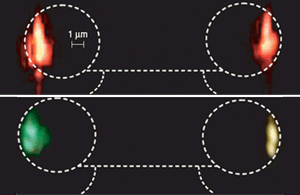 Visible Emission by 3rd Harmonic Generation.
Visible Emission by 3rd Harmonic Generation.
Nonlinear harmonic generation is widely used to extend the emission wavelength of laser sources. These devices typically require high peak powers to generate sufficient nonlinear optical response. We have demonstrated continuous-wave, visible emission from a silica microresonator on a silicon chip by third-harmonic generation. Emission is observed with pump powers <300 microWatts. Emission across the visible spectrum is shown using infrared, pump waves in the telecom band. In addition to providing low-pump-power, continuous-wave operation, this result opens a new application of silicon microphotonic devices by linking the mature telecom sources into the visible and UV bands.
Reported by Carmon, T. and Vahala, K. in Nat. Phys.
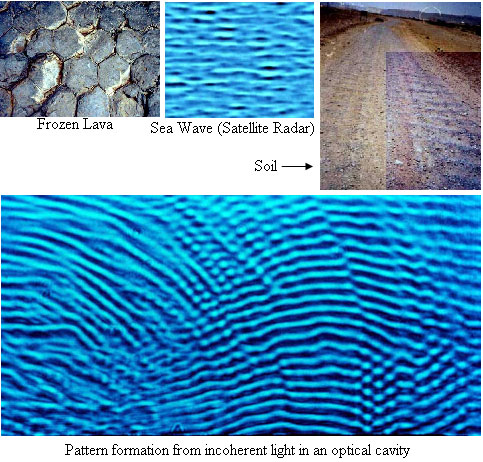 Alan Turing recognized that the formation of organized structures can arise from the interplay between reaction and diffusion (morphogenesis). Such structures are universal and form in a variety of different systems. Different examples for such systems are frozen lave, sea waves, soil pattern and more. In optics, almost all of the research on pattern formation was done with coherent light; nevertheless, as shown on the right, pattern can also forms when incoherent light circulates in a cavity. The linewidth of pattern in the spatial frequency space (lines/millimeter) becomes narrower as cavity loss is reduced; this characteristic behavior resembles the linewidth narrowing in laser systems, and, in general, characterizes systems undergoing a phase transition. When such light is also temporally incoherent, modulation depth increases with cavity loss reduction. For more see: Thesis. (images of soil and frozen lava were taken during trips in Israel in the period of my PhD studies).
Alan Turing recognized that the formation of organized structures can arise from the interplay between reaction and diffusion (morphogenesis). Such structures are universal and form in a variety of different systems. Different examples for such systems are frozen lave, sea waves, soil pattern and more. In optics, almost all of the research on pattern formation was done with coherent light; nevertheless, as shown on the right, pattern can also forms when incoherent light circulates in a cavity. The linewidth of pattern in the spatial frequency space (lines/millimeter) becomes narrower as cavity loss is reduced; this characteristic behavior resembles the linewidth narrowing in laser systems, and, in general, characterizes systems undergoing a phase transition. When such light is also temporally incoherent, modulation depth increases with cavity loss reduction. For more see: Thesis. (images of soil and frozen lava were taken during trips in Israel in the period of my PhD studies).
Carmon, T., Soljacic, M. & Segev, M.
Physical Review Letters 89, 183902 (2002).
Carmon, T., Buljan, H. & Segev, M.
Optics Express. 12, 3481 (2004).
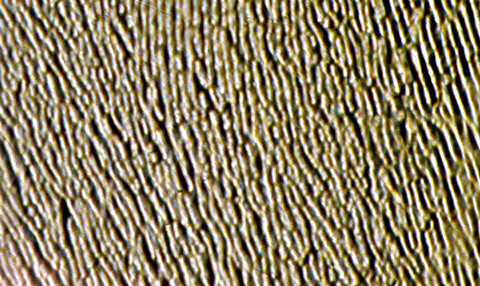 Pattern also forms when white light from a regular light bulb is propagating in a self focusing media.
Pattern also forms when white light from a regular light bulb is propagating in a self focusing media.
White light modulation instability is a collective effect, where the entire temporal spectrum of the light beam becomes unstable at the same threshold value and collectively forms a pattern with a single periodicity.
Schwartz, T., Carmon, T., Buljan, H. & Segev, M.
Physical Review Letters 93, 223901 (2004).
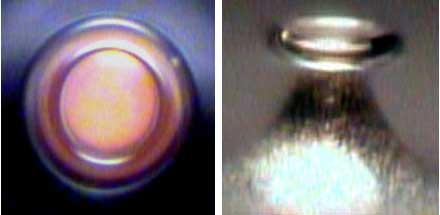 Physical nonlinearities reveal themselves when energy is increased; this is true for a simple pendulum as well as for an optical microcavity. Peculiar nonlinearity was observed recently resulting mechanical vibration in an optical cavity this nonlinearity is derived by the centrifugal radiation pressure of the light circulating in cavity. Oscillation at output power evolves from sine to a seemingly chaotic fluctuation. As higher harmonics appears, new Stokes and anti Stokes lines emerge. The fundamental law of linear momentum conservation obliges circulating light to apply centrifugal force on carrying structure. The same law is responsible for what we feel when our car hits a sharp curve. In the ring cavity on the right, photons circulate in a diameter smaller than the diameter of a human hair and consequently inflate cavity structure; inflation takes cavity out of optical resonance, this reduces circulating optical intensity till there is not enough light to maintain flex and cavity deflates back to recover resonance; cycle then repeat itself perpetually. During vibrations, pump photons convert to stokes (and anti stokes) photons via red
Physical nonlinearities reveal themselves when energy is increased; this is true for a simple pendulum as well as for an optical microcavity. Peculiar nonlinearity was observed recently resulting mechanical vibration in an optical cavity this nonlinearity is derived by the centrifugal radiation pressure of the light circulating in cavity. Oscillation at output power evolves from sine to a seemingly chaotic fluctuation. As higher harmonics appears, new Stokes and anti Stokes lines emerge. The fundamental law of linear momentum conservation obliges circulating light to apply centrifugal force on carrying structure. The same law is responsible for what we feel when our car hits a sharp curve. In the ring cavity on the right, photons circulate in a diameter smaller than the diameter of a human hair and consequently inflate cavity structure; inflation takes cavity out of optical resonance, this reduces circulating optical intensity till there is not enough light to maintain flex and cavity deflates back to recover resonance; cycle then repeat itself perpetually. During vibrations, pump photons convert to stokes (and anti stokes) photons via red  (blue) Doppler shift upon cavity inflation (deflation). It is interesting that scattering from structure vibrations was observed to sometimes coexist together with the traditional Raman lasing originates from molecular vibrations. Applications extend from quantum opto-mechanics to gravitational wave detection.
(blue) Doppler shift upon cavity inflation (deflation). It is interesting that scattering from structure vibrations was observed to sometimes coexist together with the traditional Raman lasing originates from molecular vibrations. Applications extend from quantum opto-mechanics to gravitational wave detection.
Carmon, T., Rokhsari, H., Yang, L., Kippenberg, T.J. & Vahala, K.J.
Physical Review Letters 94, 223902 (2005).
Rokhsari, H., Kippenberg, T.J., Carmon, T. & Vahala, K.J.
Optics Express 13, 5293 (2005).
Kippenberg, T.J., Rokhsari, H., Carmon, T., Scherer, A. & Vahala, K.J.
Physical Review Letters 95, 033901 (2005)
Rokhsari, H., Kippenberg, I. J., Carmon, T. & Vahala, K. J.
IEEE journal of selected topics in quantum electronics 12, 96-107 (2006)
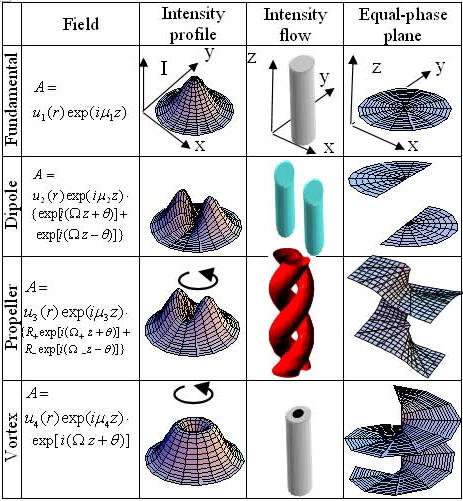 Optical solitons are very narrow optical beams that do not become wider, in spite of the broadening tendency of diffraction effects in homogeneous media. Spatial solitons exist by virtue of the balance between diffraction and nonlinearity. Observation of Dipole-Soliton with one high spatial-order component was followed by experimental demonstration of the Propeller-Soliton for which the energy structure rotates along propagation. Another soliton that carries angular momentum is the Vortex-Soliton for which the equal-phase plane is in the shape of a spiraling stairs. When such rotating-solitons clash, the outcome conserves angular momentum. For more see: Thesis.
Optical solitons are very narrow optical beams that do not become wider, in spite of the broadening tendency of diffraction effects in homogeneous media. Spatial solitons exist by virtue of the balance between diffraction and nonlinearity. Observation of Dipole-Soliton with one high spatial-order component was followed by experimental demonstration of the Propeller-Soliton for which the energy structure rotates along propagation. Another soliton that carries angular momentum is the Vortex-Soliton for which the equal-phase plane is in the shape of a spiraling stairs. When such rotating-solitons clash, the outcome conserves angular momentum. For more see: Thesis.
Carmon, T., Anastassiou, C., Lan, S., Kip, D., Musslimani, Z.H., Segev, M. & Christodoulides, D.
Optics Letters 25, 1113 (2000).
Pigier, C., Uzdin, R., Carmon, T., Segev, M., Nepomnyaschchy, A. & Musslimani, Z.H.
Optics Letters 26, 1577 (2001).
Carmon, T., Uzdin, R., Pigier, C., Musslimani, Z.H., Segev, M. & Nepomnyashchy, A.
Physical Review Letters 8714, 143901 (2001).
Rotschild, C., Cohen, O., Manela, O., Segev, M. & Carmon, T.
Physical Review Letters 95, 213904 (2005).